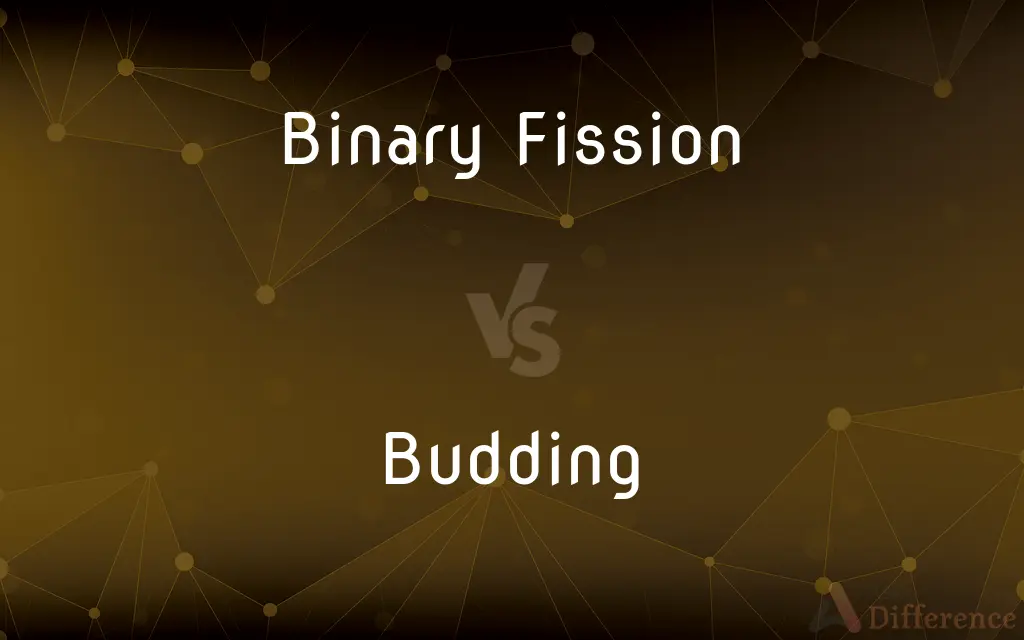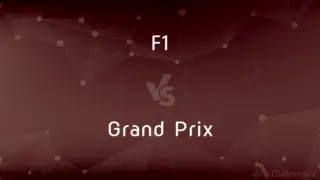Binary Fission vs. Budding — What's the Difference?
By Tayyaba Rehman — Published on December 20, 2023
Binary Fission is a method of asexual reproduction where an organism divides into two equal parts, while Budding involves the growth of a new organism from a protrusion of the parent organism.

Difference Between Binary Fission and Budding
Table of Contents
ADVERTISEMENT
Key Differences
Binary Fission is a straightforward process of asexual reproduction in which a single organism divides into two almost identical offspring. Budding, on the other hand, involves an organism forming a protrusion (or bud) that eventually detaches and becomes a new organism.
Many single-celled organisms, like bacteria, reproduce through Binary Fission. This process involves the equal division of the organism's cellular contents. In contrast, Budding is seen in yeast and certain animals where a smaller individual grows off the parent organism and eventually separates.
Binary Fission typically results in two organisms that are nearly identical in size. This process ensures a quick and efficient way for organisms to increase their numbers. Budding usually results in one larger parent organism and a smaller offspring, which might take some time to grow to the size of the parent.
In Binary Fission, the parent organism ceases to exist as it splits into two new organisms. In Budding, the parent organism remains intact and continues to live, even as it produces new offsprings through the buds.
Binary Fission is primarily a method of reproduction for prokaryotic organisms, ensuring their rapid multiplication. Budding, while also a mode of asexual reproduction, is more common in eukaryotic organisms, presenting a varied way of producing offspring without fertilization.
ADVERTISEMENT
Comparison Chart
Process Type
Asexual reproduction
Asexual reproduction
Resultant Organisms
Two equal-sized offspring
One parent and smaller offspring
Parent Organism Post-Process
Ceases to exist
Remains and can produce more buds
Typical Organisms
Prokaryotes (e.g., bacteria)
Eukaryotes (e.g., yeast, hydra)
Cell Division
Equal division
Unequal division with protrusion
Compare with Definitions
Binary Fission
Prokaryotic method of reproduction without fertilization.
Binary Fission ensures that bacteria can thrive even in challenging environments.
Budding
Produces a smaller offspring from a larger parent organism.
A hydra produces smaller tentacles through Budding, which eventually become separate organisms.
Binary Fission
Ensures rapid multiplication of single-celled organisms.
Due to Binary Fission, bacterial infections can spread quickly.
Budding
Parent organism remains intact post-process.
Even after multiple Budding events, the original yeast cell continues to exist.
Binary Fission
Asexual reproduction producing two equal offspring.
Bacteria often reproduce through Binary Fission, leading to rapid population growth.
Budding
Asexual reproduction where a new organism grows from a protrusion.
Yeast cells reproduce through Budding, leading to new cells forming from the parent.
Binary Fission
Organism splits into two nearly identical parts.
Through Binary Fission, a single bacterial cell can initiate a colony.
Budding
Common in eukaryotic organisms.
Apart from yeast, corals also reproduce through the Budding process.
Binary Fission
Parent organism divides and ceases to exist post-process.
After Binary Fission, the original organism no longer exists as it becomes two new entities.
Budding
Formation of offsprings without the need for fertilization.
Budding allows certain organisms to reproduce even in the absence of mating partners.
Budding
Being in an early developmental stage
A gallery with the works of budding artists.
Budding
Beginning to develop.
He's a budding deejay.
Budding
(horticulture) The practice of uniting a single scion bud with rootstock or bark.
Budding
(horticulture) The result of this practice.
Budding
Present participle of bud
Budding
The act or process of producing buds.
Budding
A process of asexual reproduction, in which a new organism or cell is formed by a protrusion of a portion of the animal or vegetable organism, the bud thus formed sometimes remaining attached to the parent stalk or cell, at other times becoming free; gemmation. See Hydroidea.
Budding
The act or process of ingrafting one kind of plant upon another stock by inserting a bud under the bark.
Budding
Reproduction of some unicellular organisms (such as yeasts) by growth and specialization followed by the separation by constriction of a part of the parent
Budding
Beginning to develop;
A budding genius
Common Curiosities
Which process is more common in bacteria: Binary Fission or Budding?
Binary Fission is more common in bacteria.
How do organisms reproduce through Binary Fission?
In Binary Fission, an organism divides into two equal parts, creating two nearly identical offspring.
Is Budding exclusive to single-celled organisms?
No, Budding is observed in both single-celled organisms like yeast and multicellular organisms like hydras.
How does the offspring size compare to the parent in Budding?
In Budding, the offspring (or bud) is usually smaller than the parent organism.
Can multicellular organisms reproduce through Binary Fission?
Binary Fission is typically seen in single-celled organisms, whereas multicellular organisms generally use other reproductive methods.
Are the offspring produced through Binary Fission genetically identical to the parent?
Yes, the offspring produced through Binary Fission are genetically identical to the parent.
Does Budding always produce a single offspring?
Typically, yes. Budding results in one offspring, or bud, growing from the parent organism.
Can a single organism produce multiple buds in Budding?
Yes, an organism can produce multiple buds simultaneously or sequentially through Budding.
Is Binary Fission a fast method of reproduction?
Yes, Binary Fission is a quick method, allowing organisms like bacteria to reproduce rapidly.
Does the parent organism cease to exist in Binary Fission?
Yes, in Binary Fission, the parent organism divides into two new organisms, ceasing to exist as the original entity.
Which organisms typically reproduce through Budding?
Yeast, hydras, and some species of corals are examples of organisms that reproduce through Budding.
How does the bud detach from the parent in Budding?
The bud grows until it reaches a certain size and then naturally detaches or separates from the parent organism.
What ensures the equal division of cellular content in Binary Fission?
The organism's cellular machinery and specific checkpoints ensure the equal division of content during Binary Fission.
Can Budding occur in plants?
Yes, certain plants can produce buds that can develop into new plants, although this isn't Budding in the same sense as in yeast or hydras.
Is genetic diversity achieved through Binary Fission?
No, Binary Fission results in genetically identical offspring, so there's no genetic diversity from this process.
Share Your Discovery

Previous Comparison
F1 vs. Grand Prix
Next Comparison
Apology vs. ForgivenessAuthor Spotlight
Written by
Tayyaba RehmanTayyaba Rehman is a distinguished writer, currently serving as a primary contributor to askdifference.com. As a researcher in semantics and etymology, Tayyaba's passion for the complexity of languages and their distinctions has found a perfect home on the platform. Tayyaba delves into the intricacies of language, distinguishing between commonly confused words and phrases, thereby providing clarity for readers worldwide.
















































